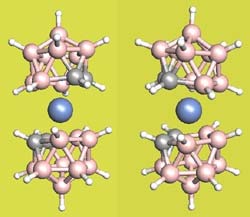Step towards building tiny, molecular motors

Illustration shows how the “molecular motor” is composed of a molecule made up of two spheres, rotating on a common axis between them. In the double-sphered molecule at right, two carbon atoms (grey) are shown on the left-hand side of both spheres of the molecule. In the molecule at left, the upper sphere of the molecule has rotated counter-clockwise by 144 degrees and locked in position, the result being that the carbon atoms can now be seen in the top sphere on the right-hand side. The other atoms in the illustration are nickel (blue) and hydrogen (pink). The straight bars connecting the atoms represent chemical bonds
Achieved by Hebrew University, UCLA scientists
A step towards building tiny motors on the scale of a molecule has been demonstrated by researchers at the Hebrew University of Jerusalem and the University of California at Los Angeles (UCLA).
In an article appearing in the current issue of Science magazine, the researchers from the two institutions described how they were able – through light or electrical stimulation – to cause a molecule to rotate on an axis in a controlled fashion, similar to the action of a motor.
The consequences of such an achievement could lead to the design of molecular devices on a “nano” scale (one billionth of a meter), capable of operating industrial or surgical processes that larger equipment could not handle.
The researchers who wrote the article for Science are Prof. Roi Baer of the Institute of Chemistry at the Hebrew University of Jerusalem, along with his graduate student, Esther Livshits, and Prof. Daniel Neuhauser, Prof. M. Frederick Hawthorne, Dr. Jeffrey I. Zink, Johnny M. Skelton, Dr. Michael J. Bayer and Chris Liu of the University of California at Los Angeles.
Prof. Baer explained that tiny “machines” already exist in natural biological systems. For example, certain bacteria are equipped with a small molecular motor that rotates a flagellum and allows the bacteria to move and navigate in water. The “fuel:” driving these motors is energy-rich molecules, abundant in the living cell, that are programmed to release their stored energy.
The challenge for scientists is to design man-made molecular motors – not necessarily confined to living cells — that can be controlled and powered using light or electricity. Such man-made motoric actions have been achieved in the past, but the Hebrew University-UCLA team says it is the first to achieve motion that can be halted. This is important because in order for a tiny molecular motor to have any practicality, it must be capable of being stopped or locked in position. This would enable molecular devices to be used, for example, as tiny switches or to perform other mechanical tasks.
Molecular machines are still a long way down the road, said Prof. Baer. But it is clear that once such a technology is available, it will be possible to design new materials and control their properties with extremely high precision. It will also be possible to manipulate and intervene in the most delicate processes in the living cell – with at present unimaginable benefits for medical experimentation and ultimately treatment.
The molecule used by the researchers was composed of four elements – boron, carbon, nickel and hydrogen. The nickel was the key to the process, since it is capable of bonding in several ways in molecules.
The model developed is composed of two spherical structures with a common axis. When exposed to light or electrical stimulation, the top sphere rotates with respect to the bottom one by an angle of 144 degrees. After this rotation, the molecule is locked into its new position.
By measuring the absorption, emission and scattering of light from the molecule and using detailed theoretical calculations, the researchers were able to study the intricate mechanism of the molecule’s operation. They are now trying to find a way of chemically bonding one of the spheres of the molecule to a surface and attaching a molecular chain to the other sphere, capable of performing a rotary task on demand (a kind of mini-motor). Further, by attaching two molecules together along their axes, say the scientists, rotations other than 144 degrees could be achieved.
Media Contact
More Information:
http://www.huji.ac.il/huji/eng/All latest news from the category: Life Sciences and Chemistry
Articles and reports from the Life Sciences and chemistry area deal with applied and basic research into modern biology, chemistry and human medicine.
Valuable information can be found on a range of life sciences fields including bacteriology, biochemistry, bionics, bioinformatics, biophysics, biotechnology, genetics, geobotany, human biology, marine biology, microbiology, molecular biology, cellular biology, zoology, bioinorganic chemistry, microchemistry and environmental chemistry.
Newest articles

Combatting disruptive ‘noise’ in quantum communication
In a significant milestone for quantum communication technology, an experiment has demonstrated how networks can be leveraged to combat disruptive ‘noise’ in quantum communications. The international effort led by researchers…

Stretchable quantum dot display
Intrinsically stretchable quantum dot-based light-emitting diodes achieved record-breaking performance. A team of South Korean scientists led by Professor KIM Dae-Hyeong of the Center for Nanoparticle Research within the Institute for…

Internet can achieve quantum speed with light saved as sound
Researchers at the University of Copenhagen’s Niels Bohr Institute have developed a new way to create quantum memory: A small drum can store data sent with light in its sonic…





















